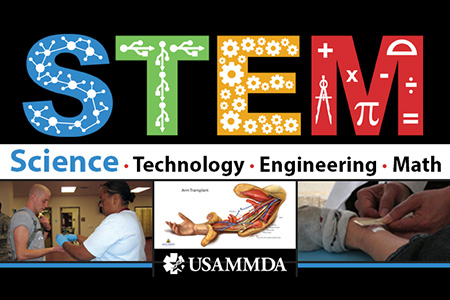USAMMDA STEM Series: "S" is for Science

In the late 1990s, the acronym "STEM" was introduced into contemporary language to convey collectively the academic disciplines of science, technology, engineering and math. Typically, STEM coursework is now part of the educational curriculum in both middle and high school, and is traditionally conveyed via hands-on lessons and activities that apply to real-world scenarios. Young students often respond well to this approach, and it usually helps to engage those who may not have been interested previously in STEM subjects.
According to the U.S. Department of Commerce's STEM Jobs: 2017 Update, employment in STEM occupations grew much faster than employment in non-STEM occupations over the past decade (24.4 percent versus 4.0 percent, respectively), and STEM occupations are projected to grow by 8.9 percent from 2014 to 2024, compared to 6.4 percent growth for non-STEM occupations. Further, members of the STEM workforce command higher wages, earning 29 percent more than their non-STEM counterparts in 2015.
In light of these statistics, most might agree that guiding our younger generation into the field of STEM studies early on could produce a win–win situation for all involved and, in the process, help to strengthen our nation's cadre of scientific researchers.
With a mission to develop and deliver quality medical capabilities to protect, treat and sustain the health of Service Members worldwide, team members of the U.S. Army Medical Materiel Development Activity at Fort Detrick, Maryland, are well acquainted with the core STEM areas of study. Because it fosters an environment that daily utilizes science, technology, engineering and math to conduct its critical work, USAMMDA seeks candidates that have solid training in STEM coursework.
To provide a better picture of the STEM curriculum, it would be helpful to consider each of the four components individually, so these will be presented in a series of articles beginning here. The intent is to highlight how the S, T, E and M relate to the overarching mission of USAMMDA.
So, let's start with "S": Science.
While the term "science" may certainly cover a broad spectrum of study, the core subjects with regard to STEM are traditionally considered to fall within the "natural sciences," and these typically include biology, ecology, chemistry and physics. As biology is the study of life and living organisms, ecology looks at the relationships of these organisms to each other and to their surroundings. Chemistry coursework investigates the structure and properties of various types of matter, while in physics, one studies matter forms along with their unique behaviors.
If this all sounds interesting, that's because it is – and, believe it or not, thorough knowledge in these science areas remains extremely vital to our national defense.
For example, the men and women of USAMMDA's Pharmaceutical Systems Project Management Office must continually utilize their knowledge of biology, ecology and chemistry as they are tasked with managing the development and acquisition of pharmaceutical and biological products – such as drugs, vaccines and therapeutics – to halt or prevent infectious diseases throughout our nation's military forces. In a nutshell, the work of the PSPMO helps to keep our Warfighters ready and strong, which offers a greater sense of security to our citizens as well.
In its current development portfolio, the PSPMO manages Adenovirus Vaccine, Types 4 and 7, which helps to combat acute respiratory disease in military recruits during basic training. A new, improved version of this vaccine is now in development. The PSPMO also oversees the work being conducted on Topical Paromomycin for treating cutaneous leishmaniasis, and Intravenous Artesunate to help battle severe and complicated malaria among our Warfighters.
Of course, USAMMDA's PSPMO is only one example of its team putting STEM science training into action. Other groups such as the Tissue Injury and Regenerative Medicine, Medical Support Systems, and Neurotrauma & Psychological Health PMOs may utilize biology, ecology, chemistry and physics throughout their work as well, and the results are equally successful. Future articles within this series will showcase the efforts of other USAMMDA teams, and how their STEM-related work helps to support both our military forces and our civilian population.
As a subordinate command of the U.S. Army Medical Research and Materiel Command, USAMMDA stands as the Department of Defense's advanced development activity for products to protect and preserve the lives of Warfighters across the globe. As the premier developer of world-class military medical capabilities, USAMMDA's work is not only far-reaching, it is truly life-saving.
So, I guess one could say that when it comes to saving lives, for USAMMDA, its positive results may truly stem from STEM.













